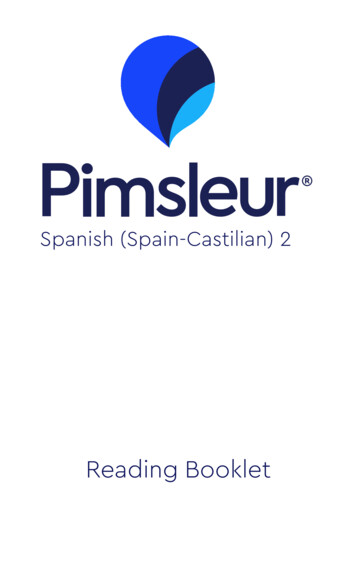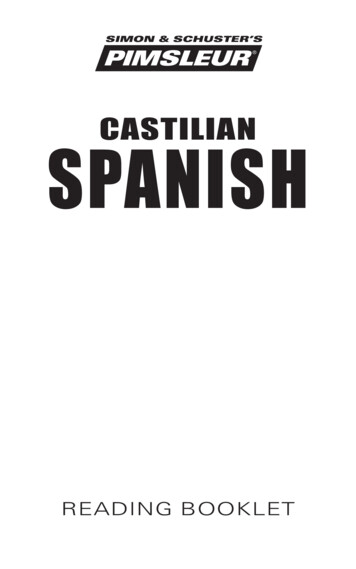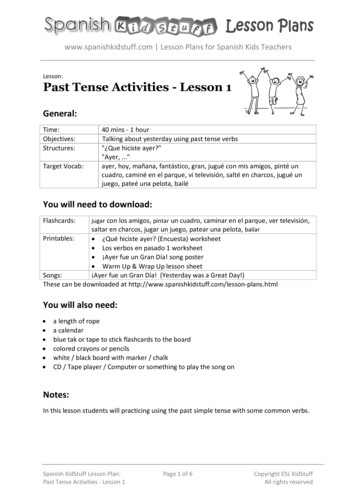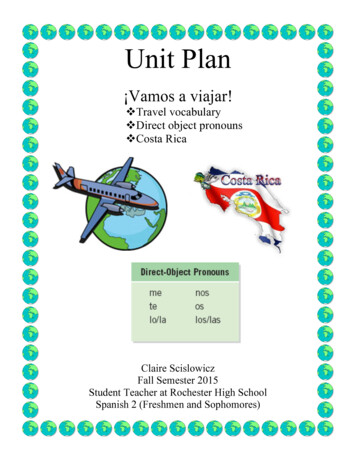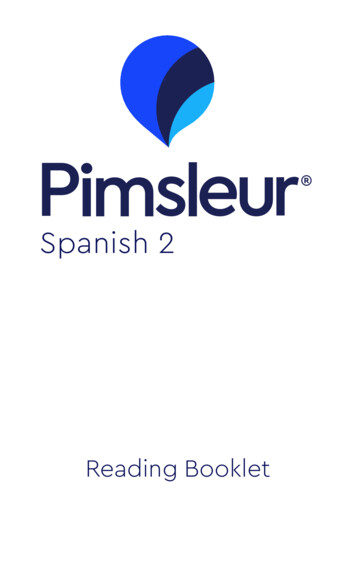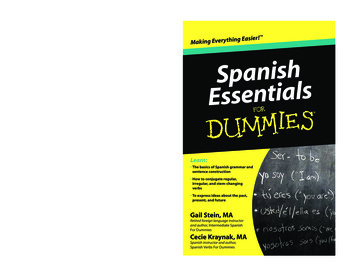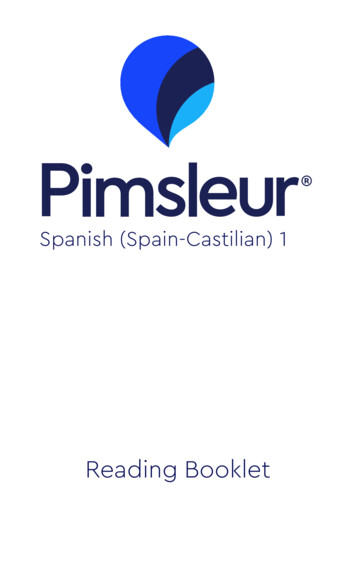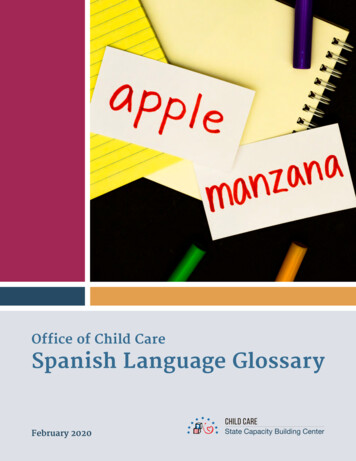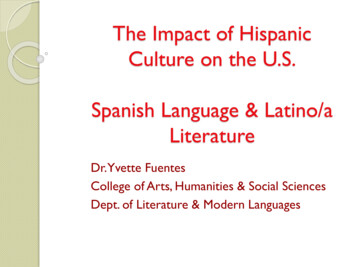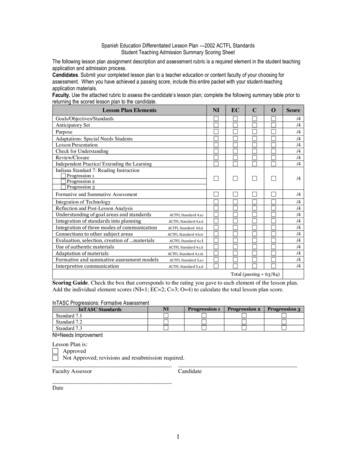
Transcription
Spanish Education Differentiated Lesson Plan —2002 ACTFL StandardsStudent Teaching Admission Summary Scoring SheetThe following lesson plan assignment description and assessment rubric is a required element in the student teachingapplication and admission process.Candidates. Submit your completed lesson plan to a teacher education or content faculty of your choosing forassessment. When you have achieved a passing score, include this entire packet with your student-teachingapplication materials.Faculty. Use the attached rubric to assess the candidate’s lesson plan; complete the following summary table prior toreturning the scored lesson plan to the candidate.Lesson Plan ipatory SetPurposeAdaptations: Special Needs StudentsLesson PresentationCheck for UnderstandingReview/ClosureIndependent Practice/ Extending the LearningIndiana Standard 7: Reading Instruction Progression 1 Progression 2 Progression 3Formative and Summative AssessmentIntegration of TechnologyReflection and Post-Lesson AnalysisUnderstanding of goal areas and standardsIntegration of standards into planningIntegration of three modes of communicationConnections to other subject areasEvaluation, selection, creation of materialsUse of authentic materialsAdaptation of materialsFormative and summative assessment modelsInterpretive communicationACTFL Standard 4.a.iACTFL Standard 4.a.iiACTFL Standard 4.b.iiACTFL Standard 4.b.ivACTFL Standard 4.c.iACTFL Standard 4.c.iiACTFL Standard 4.c.iiiACTFL Standard 5.a.iACTFL Standard 5.a.ii /4/4/4/4/4/4/4/4 /4 /4/4/4/4/4/4/4/4/4/4/4/4Total (passing 63/84)Scoring Guide. Check the box that corresponds to the rating you gave to each element of the lesson plan.Add the individual element scores (NI 1; EC 2; C 3; O 4) to calculate the total lesson plan score.InTASC Progressions: Formative AssessmentInTASC StandardsStandard 7.1Standard 7.2Standard 7.3NI Progression 1 Progression 2 Progression 3 NI Needs ImprovementLesson Plan is: Approved Not Approved; revisions and resubmission required.Faculty AssessorCandidateDate1
INDIANA WESLEYAN UNIVERSITYSpanish Lesson Plan Assignment Description and Assessment Rubric2002 ACTFL StandardsAdministration and Purpose. While your lesson plans will be assessed multiple times throughoutyour program of study, your “official” lesson plan is assessed as part of the materials you will submitwith your student teaching admission application. You will choose your assessor from the teachereducation faculty.The lesson plan assessment has three related purposes. The first and perhaps most obvious is todocument your ability to plan effective instruction; this is one of the hallmarks of the best, mostsuccessful teachers. These teachers consider not only the needs of their students as they plan, butalso multiple pathways to achieve learning goals for each lesson so that each students becomes asuccessful learner. The second purpose is to habituate you to the instructional cycle. It consists ofplanning for and delivering instruction, assessing student learning, modifying future lessons basedon assessment data, followed by planning for new lessons. The cycle does not end until all studentslearn the intended material. The third, overarching purpose of the lesson plan assessment is toprovide you with the means to internalize the discipline necessary to become a successful teacher.The fact is that no teacher, no matter how talented, will ever achieve long-term effectiveness withdiverse populations of students without developing the self-discipline necessary to plan effectiveinstruction, consistently, over time.Content of Assessment. The lesson plan assessment is divided into the following sections:Readiness. Preparing the groundwork for effective instruction.Plan for Instruction. The blueprint that guides your instruction for each lesson.Plan for Assessment. Your plan for determining how well your students learn what you teach.Reflection and Post-Lesson Analysis. One of the characteristics of the most successful teachers is thatthey reflect on their teaching. They think about what went well and what could be improved in eachlesson, and they take steps to make each lesson better than the last.In addition to these lesson plan elements, this assessment also includes the following alignments: American Council on the Teaching of Foreign Languages (ACTFL) 2002 standards. The IWUSpanish education program is nationally recognized by ACTFL; this assessment is one of severalused to affirm the strength of our program by that organization. Interstate New Teacher Assessment and Support Consortium (InTASC). The InTASC Standardsoutline the common principles and foundations of teaching practice that cut across all subjectareas and grade levels and that are necessary to improve student achievement. The ten InTASCStandards are incorporated into this assessment, and are divided into four categories: Learner and Learning (InTASC Standards 1, 2 and 3) Content (InTASC Standards 4 and 5) Instructional Practice (InTASC Standards 6, 7 and 8) Professional Responsibility (InTASC Standards 9 and 10) Diversity Thread. Teacher candidates are expected to teach all students well. Technology Thread. Teacher candidates are expected to integrate technology into their teachingas a means to improve student learning.Criterion for Success. Candidates must achieve a rating of Competent to pass this assessment. For thisassessment, Competent is defined as 80% or more of all rubric elements scored as competent or higher.No domain or assessment element may be scored as Needs Improvement.2
Indiana Wesleyan University Differentiated Lesson PlanSpanish Education—2002 ACTFL StandardsAssignment DescriptionThe Indiana Wesleyan University differentiated lesson plan combines elements of theDirect Instruction lesson-planning model with elements requiring the candidate todifferentiate and modify plans, activities, and assessments to meet the needs of allstudents. The candidate will utilize concepts in learning theory, curriculum developmentand instructional effectiveness to produce lesson plans that are aligned with IndianaWorld Languages standards, INTASC principles, and American Council on the Teachingof Foreign Languages (ACTFL) standards.The concept of differentiated instruction is founded on an active, student centered,meaning-making approach to teaching and learning. The theoretical and philosophicalinfluences embedded in differentiated instruction include these key elements: readiness,interest, and learner profile.1The Spanish education lesson plan format includes the follow elements: readiness(goals/objectives, standards, anticipatory set), instruction (input, modeling, checking forunderstanding), accommodation (addressing the needs of students with exceptionalcircumstances and conditions), and assessment.Additionally, the Spanish education lesson plan includes a final evaluation section for thecandidate to self-assess the degree to which the lesson was taught successfully. Thesepost-lesson self-analysis questions are designed to help the candidate think about theinstructional process and how it might be improved in future lessons.The Spanish education lesson plan design structure is as follows:Spanish Education Differentiated Lesson Plan2002 ACTFL StandardsNameREADINESSI. Goals/Objectives/Standard(s)A. Goal(s)—UnitB. Objective(s).Provide: 1.) conditions; 2.) desired learning; 3.) observable behavior; and 4.)accuracy (as necessary)C. Standard(s): learned society; state; district.ACTFL Standard 4.a.i Understanding of goal areas and standards.ACTFL Standard 4.a.ii Integration of standards into planning.II. Anticipatory Set This is a “bridge” from the past learning to present learning Must be understood by allIII. Purpose: must be stated to the students! Why do we need to learn this?1Tomlinson, C., and S. Allen (2000). Leadership for Differentiating Schools & Classrooms. Alexandria, VA: ASCD.3
PLAN FOR INSTRUCTIONIV. Adaptations: students with special needs. Depending on the nature and complexityof the lesson, what adjustments and/or adaptations will you make to accommodateall students in the class? Remediation: students who didn’t master the objective(s) Enrichment: gifted/mastery students ESL—mainstreamed Others?V. Lesson Presentation (Input/Output) Include: active participation and questions to be asked Include: technology and adaptations for students with special needs Include: modeling/monitoringACTFL Standard 4.b.ii Integration of three modes of communicationACTFL Standard 4.b.iii Integration of cultural products, practices, perspectivesACTFL Standard 4.b.iv Connections to other subject areasMaterials. Evaluate, select, and create instructional materials to actively engagestudents, enabling them to achieve learning outcomes. Materials may includevisuals, realia, authentic printed and oral texts, and other authentic materialsobtained through technology (e.g., Internet).ACTFL Standard 4.c.i Evaluation, selection, creation of standards-based materialsACTFL Standard 4.c.ii Use of authentic materialsACTFL Standard 4.c.iii Adaptation of materialsVI. Check for understanding. How do you know students have learned? Whatstrategies will you implement if all students have not met lesson outcomes? Employone or more strategies to determine student learning: Guided practice. Teacher models; students complete exercises with the teacher;the teacher checks for understanding before students work alone. Reteach: whole group, small group, individuals Suggested strategies: index card summaries; hand signals; questionboard/box; concept maps; oral questioning; follow-up probes; misconceptionchecksVII. Review learning outcomes / ClosureVIII. Independent practice/extending the learning If the checking for understanding has gone well, students are ready to completean assignment alone. The assignment must relate directly to learning outcomes.PLAN FOR READING (AND WRITING) INSTRUCTIONAt its most basic, teaching reading in the content areas is helping learners to makeconnections between what they already know and “new” information presented in thetext. As students make these connections, they create meaning; they comprehend whatthey are reading. Teaching reading in the content areas, therefore, is not so much aboutteaching students basic reading skills as it is about teaching students how to use readingas a tool for thinking and learning. Until recently, learning was thought to be a passive4
activity: teachers poured their knowledge into the receptive minds of students. Readingwas thought to be passive as well. The words of the text contained meaning; readingsimply entailed decoding the words on the page. Recent research indicates, however, thatlearning and reading are active processes. Readers construct meaning as they read.Effective readers are strategic. They make predictions, organize information, andinteract with the text. They evaluate the ideas they are reading about in light of what theyalready know. They monitor their comprehension, and know when and how to modifytheir reading behaviors when they have problems understanding what they read.2Teaching reading is a complex process. The best teachers develop an extensiveknowledge base and draw on a repertoire of strategies for working with strugglingstudents. Specifically, all teachers should learn how to provide effective vocabularyinstruction in their subject areas; all teachers should learn how to provide instruction inreading comprehension strategies that can help students make sense of content-areatexts; all teachers should learn how to design reading and writing assignments that arelikely to motivate students who lack engagement in school activities; and all teachersshould learn how to teach students to read and write in the ways that are distinct to theirown content areas.3As you plan for literacy development in the context of your lesson content, alsoincorporate these or other strategies in your lesson plan to build your students’ readingand writing skills:Strategy 1:Provide explicit instruction and supportive practice in the use of effectivecomprehension strategies throughout the lesson.4Strategy 2: Increase the amount and quality of open, sustained discussion of readingcontent.Strategy 3: Set and maintain high standards for text, conversation, questions, andvocabulary.Strategy 4: Increase students' motivation and engagement with reading.Strategy 5: Teach essential content knowledge so that all students master criticalconcepts.PLAN FOR ASSESSMENT. Develop a plan for assessing the degree to which yourstudents have mastered the learning outcomes from this lesson. Your plan shouldinclude formative assessments at a minimum, and may also include summative and/orauthentic assessments depending on the nature of the learning outcomes and theplacement of the lesson within the context of the unit.Formative. Formative assessments are on-going assessments, reviews, and observations in aclassroom. Use formative assessment to improve instructional methods and student feedbackthroughout the teaching and learning process. For example, if some students do not grasp aconcept, you might design a review activity or use a different instructional strategy. Likewise,students can monitor their progress with periodic quizzes and performance tasks. The results offormative assessments are used to modify and validate instruction.Adapted from http://www.ascd.org/ascd/pdf/books/billmeyer1998 sample chapters.pdf; retrieved from the internet onJuly 12, 2017.2Adapted from http://www.adlit.org/adlit 101/improving literacy instruction in your school/teaching reading and writing content areas/;retrieved from the internet on July 12, 2017.4 Adapted from http://www.adlit.org/article/19999/; retrieved from the internet on July 12, 2017.35
Summative. Summative assessments are typically used to evaluate the effectiveness ofinstructional programs and services at the end of lesson or instructional unit. The goal ofsummative assessment is to make a judgment of student competency after an instructional phaseis complete. Summative evaluations are used to determine if students have mastered specificcompetencies and to identify instructional areas that need additional attention. 5Authentic. Authentic assessment is a form of assessment in which students are asked toperform real-world tasks that demonstrate meaningful application of essential knowledge andskills. These tasks—authentic assessments—are either replicas of or analogous to the kinds ofproblems faced by adults or consumers or professionals in the field. Authentic assessmentrequires students to demonstrate specific skills and competencies, that is, to apply the skills andknowledge they have mastered. An authentic assessment usually includes a task for students toperform and a rubric by which their performance on the task will be evaluated. 6Authentic assessment can be either a short-term or long-term assignment for students. There isno specific length of time attached to an authentic assessment learning opportunity. However,"within a complete assessment system, there should be a balance of longer performanceassessments and shorter ones" (Valencia, 1997). According to Lawrence Rudner, authenticassessment should require that students be active participants in learning and be able todemonstrate knowledge and skills. The following is a list of examples of authentic assessment thatmeet one or both of these requirements - active participation and/or demonstration of knowledgeand skills. As you read through this list, keep in mind that some of the examples will work betterfor you depending on your grade level and topic area. Make a note of the examples of assessmentthat you could use in your own classroom. 7Authentic Assessment examples: Conduction research and writing a report Character analysis Student debates (individual or group) Drawing and writing about a story or chapter Experiments - trial and error learning Journal entries (reflective writing) Discussion partners or groups Student self-assessment Peer assessment and evaluation Presentations Projects PortfoliosACTFL Standard 5.a.i Formative and summative assessment modelsACTFL Standard 5.a.ii Interpretive communicationAdapted from http://fcit.usf.edu/assessment/basic/basica.html. Taken from the Internet on July 20 2012.Adapted from it.htm. Taken from the Internet on July 20, 2012.7 Taken from http://tccl.rit.albany.edu/knilt/index.php/Unit 2: Types of Authentic Assessment on July 23, 2012.566
REFLECTION AND POST-LESSON ANALYSIS1. How many students achieved the lesson objective(s)? For those who did not,why not?2. What were my strengths and weaknesses?3. How should I alter this lesson?4. How would I pace it differently?5. Were all students actively participating? If not, why not?6. What adjustments did I make to reach varied learning styles and ability levels?a. Bloom’s Taxonomyb. Gardner’s Multiple Intelligences7
Indiana Wesleyan UniversitySpanish Education Lesson Plan Design and Assessment RubricReadinessGoals/Objectives/StandardsINTASC 4AnticipatorySetNeeds ImprovementLesson objectives arepoorly written and/orhave little or noconnection to learninggoals or standards. Littleconnection exists betweenobjectives and lessonactivities and assessments.Emerging CompetenceLesson objectives arecorrelated with learninggoals and standards. Theconnection betweenobjectives and lessonactivities and assessmentsis weak or unclear.CompetentThe lesson plan containsobjectives that connectgoals and standards withLP activities andassessments.OutstandingThe lesson plan containsclearly stated contentobjectives. Objectives arelogically connected toappropriate goals andstandards and areconsistent with lessonactivities andassessments.The anticipatory set ismissing or has little or noconnection to the goal orcontent of the lesson.The connection betweenthe anticipatory set andlesson objectives andcontent is weak or unclear.The anticipatory set is clearand direct and focusesstudents’ attention on thelesson.The statement of purpose isambiguous or worded sogenerally that theconnection with the contentof the lesson is notapparent.A statement of purpose isincluded in the LP, but haslittle power to motivatestudents and capture theirimaginations.The statement of purposeis clearly connected to thecontent of the lesson and ispresented in terms that areeasily understood bystudents.The anticipatory setconnects the current lessonwith previous and futurelearning and focusesstudents’ minds andattention on the day’slesson.The statement of purposehas the power to capturethe imaginations ofstudents and motivate themto accomplish the expectedlearning.Needs ImprovementFew or no adaptations areincluded for students withspecial needs.Emerging CompetenceLesson adaptations arewritten generally and/or arenot designed to meetspecific learning issues ofindividual students.CompetentPlans for differentiatinginstruction are included;adequate and appropriateadaptations are includedfor all students who requirethem.OutstandingThe LP includesdifferentiated instruction forstudents with specialneeds; lesson adaptationsare thoughtfully andthoroughly planned and aredesigned to bring allstudents into fullparticipation and mastery oflesson goals andobjectives.The presentation does notinvolve the activeparticipation of students.Essential questions are notlisted or are unrelated tothe content of the lesson.Little or no provision ismade for technology ordiverse students.The presentation includesactivities that have littlerelation to the content ofthe lesson. Essentialquestions are poorly writtenor are not adequate for thescope of the lesson.Provisions for technologyand diverse students areinadequate.The lesson presentationprovides for the activeparticipation of students.Essential questions arelisted; provisions fortechnology and diversityissues are included.The lesson presentation isclearly designed to activelyinvolve all students for theduration of the learningprocess. Essential questionsare designed to causestudents to think deeply andcritically about the content ofthe lesson. Technology isintegrated seamlessly andappropriately. The learningneeds of all students areaccounted for in thepresentation section.InTASC Standard8PurposeInstructionAdaptations:Special NeedsStudentsInTASC Standard 2DiversityLessonPresentationInTASC Standard 5Little or no provision ismade for modeling ormentoring of students.Plans for teacher modelingand mentoring of studentscould be better developed.8The modeling andmonitoring of student workand learning sections areincluded in sufficient detail.Teacher modeling andmentoring of students isdesigned to help all learnersunderstand and master thecontent of the lesson.
Instruction, con’t.Check forUnderstandingInTASC Standard 4Review/closureNeeds ImprovementLittle or no provision isincluded to check forstudent understanding or toreteach concepts thatelude students during theinitial presentation.Emerging CompetenceA guided practice section isincluded in the lesson plan,but the connection with thelesson presentation is weakand/or unclear.CompetentThe lesson plan includes aplan and the means tocheck for studentunderstanding of thelesson. A provision isincluded to reteach all orpart of the lesson to all orpart of the class.Lesson closure is notincluded, or is not relatedto the goals and/or contentof the lesson.Lesson closure is weakand/or poorly written.Lesson closure relatesdirectly to the lessonpurpose and/or objective.No independent practiceactivities are included inthe lesson, or activities areunrelated to the content ofthe lesson.Independent practiceactivities are not wellconceived and/or written;student accomplishment ofIP activities is not likely toresult in lesson mastery.Assignments or activitiesare included that providestudents with theopportunity to practicelearned skills; All activitiesmatch lesson objectives.InTASC Standard 4IndependentPractice/Extending theLearningInTASC Standard 5OutstandingPlans to check for studentunderstanding of thecontent are an integral partof the lesson, and includefrequent questions andother actively engagingforms of formativeassessment during guidedpractice.Lesson closure is clearlycorrelated to the content ofthe lesson and activelyengages students insummarizing the essentialelements of the lesson.Independent practiceactivities are highlycorrelated to lessonobjectives and content andlead to student mastery.Indiana Standard 7: Reading InstructionNeedsImprovementIndianaStandard 7:ReadingInstruction. Thecandidate has abroad andcomprehensiveunderstanding ofcontent-area anddisciplinary literacyskills, anddemonstrates theability to plan anddeliver integratedcontent-areareading instructionthat is based onstudent learningstandards, studentliteracy needs andstrengths asreflected in ongoingstudent data, andscientifically basedreading research.The candidate does notincorporate foundations ofcontent-area or disciplinaryliteracy in his or her lessonplanning or instructionaldelivery;Or He or she fails to selectevidence-based readinginstruction based on SBRR orRtI elements;Or Does not use evidence-basedinstructional practices todevelop students’ writing skillsin his or her discipline.Progression 1Progression 2Progression 3The candidate Employs skills and practicesof effective content-areareading instruction basedon SBRR and RtI elements,including evidence-basedinstructional strategies thatare aligned to learninggoals and student needs;And Uses evidence-basedinstructional strategies todevelop students’vocabulary and languagerelated to content-areareading and writing in his orher discipline;And Uses evidence-basedinstructional practices todeepen comprehension,and to develop students’text-based reading skillsand their use ofcomprehension strategies inhis or her disciplineProgression 1 And The candidate Uses ongoing student datato inform reading-relatedinstruction;And Uses evidence-basedskills and strategies forfacilitating students’comprehension beforeduring, and after readingcontent-area texts in his orher discipline.And Uses evidence-basedinstructional practices todevelop students’ writingskills in his or herdiscipline.Progression 2 And The candidate Uses evidence-basedpractices effectively tocreate a literacy-richclassroom environmentthat fosters and supportsthe literacy development ofall students;And Engages all students asagents in their own literacydevelopment.ECCO9ECCOECCO
AssessmentFormative andSummativeAssessmentInTASC Standard 6Needs ImprovementEmerging CompetenceCompetentOutstandingThe lesson plan does notinclude assessmentactivities, or there is littleor no correlation betweenplanned assessmentactivities and lesson goalsand objectives.Assessment activities areincluded in the lesson,but they are not wellcorrelated to and/or donot cover the full rangeof LP goals andobjectives.A plan for informal,ongoing assessmentthroughout the lesson isincluded. A summativeassessment plan isincluded if appropriatefor the lesson.Formative andsummative assessmentactivities are a seamlessand integrated part ofthe lesson. Assessmentactivities are highlycorrelated with the goalsand objectives of thelesson.TechnologyTechnologyInTASC Standard 7Technology ThreadNeeds ImprovementEmerging CompetenceCompetentOutstandingThe lesson plan reflectseducational decision makingregarding availabletechnology that adverselyimpacts student learningand/or fails to engagestudents at the necessarylevel to meet lessonobjectives.The lesson plan reflectsinsufficient or misaligneddecision making regardingavailable technology;statements indicating theuse of instructional,assistive, or othertechnologies are written ingeneral terms or in termsunlikely to impact studentlearning.The lesson plan reflectseducationally sounddecisions regardingavailable technology(including, but not limitedto, instructional andassistive technologies) tosupport learner needs andthe curriculum.The lesson plan reflectseducationally sounddecisions regardingavailable technology(including, but not limitedto, instructional andassistive technologies) thatengage students, enhancethe learning process, and/orextend opportunities forlearning.Needs ImprovementSelf-answer questions arenot included in the lessonplan.Emerging CompetenceSelf-answer questions areincluded, but do not fit thecontent or purposes of thelesson.CompetentThe lesson plan includes allrequired self-answerquestions.OutstandingAdditional self-answerquestions are includedthat specifically addressunique lesson content andmethodology.Needs ImprovementThe candidate cannotname the goal areas andstandards of the Standardsfor Foreign LanguageLearning, or identify thesimilarities between his orher state and nationalforeign languagestandards.The candidate does notapply goal areas andstandards (both nationaland state) to his or herplanning.Emerging CompetenceThe candidate names thegoal areas and standardsof the Standards forForeign LanguageLearning, and identifies thesimilarities between his orher state and nationalforeign languagestandards.The candidate applies goalareas and standards (bothnational and state) to his orher planning to the extentthat his or her instructionalmaterials do so.CompetentThe candidate describeshow the goal areas andstandards (both nationaland state) are addressed ininstructional materialsand/or classroom activities.OutstandingThe candidate uses thenational and state foreignlanguage standards as arationale for thesignificance of languagestudy.The candidate createsunit/lesson plan objectivesthat address specific goalareas and standards(national and state). He orshe designs activitiesand/or adapts instructionalmaterials.The candidate lacksunderstanding of theconnection among theinterpersonal, interpretive,and presentational modesof communication.The candidate understandsthe connection among theinterpersonal, interpretive,and presentational modesof communication. He orshe focuses on one modeat a time in instruction andclassroom activities.The candidate designsopportunities for his or herstudents to communicateby using the interpersonal,interpretive, andpresentational modes in anintegrated manner.The candidate uses thegoal areas and standardsof the Standards forForeign LanguageLearning, as well as his orher state standards, todesign curriculum andactivities to addressspecific standardsThe candidate uses theinterpersonal-interpretivepresentational frameworkas the basis for planningand implementingclassroom communication.EvaluationReflection andPost-LessonAnalysisInTASC Standard 9ACTFL StandardsUnderstandingof goal areasand standardsACTFL Standard 4.a.iIntegration ofstandards intoplanningACTFL Standard 4.a.iiIntegration ofthree modes ofcommunicationACTFL Standard 4.b.ii10
ACTFL Standards, con’t.Needs ImprovementThe candidate has minimalunderstanding of theanthropological view ofCulturalculture in terms ofproducts,products, practices, andpractices,perspectives. He or sheperspectivesACTFL Standard 4.b.iiidoes not refer to theseareas in his or her teachingof culture.The candidate does notmake connections to othersubject areas in his or herinstructional materials.Connections toother subjectareasEmerging CompetenceThe candidate understandsthe anthropological view ofculture in terms ofproducts, practices, andperspectives. He or sherefers to one or more ofthese areas in his or herteaching of culture.CompetentThe candidate designsopportunities for his or herstudents to explore thetarget language culture(s)by means of culturalproducts, practices, andperspectives.OutstandingThe candidate uses theproducts-practicesperspectives framework asthe basis for planning andimplementing culturalinstruction.The candidate makesconnections to othersubject areas as theseconnections are made inhis or her instructionalmaterials
Spanish Education Differentiated Lesson Plan —2002 ACTFL Standards Student Teaching Admission Summary Scoring Sheet The following lesson plan assignment description and assessment rubric is a required element in the student teaching application and admission process. Candidates. Submit

